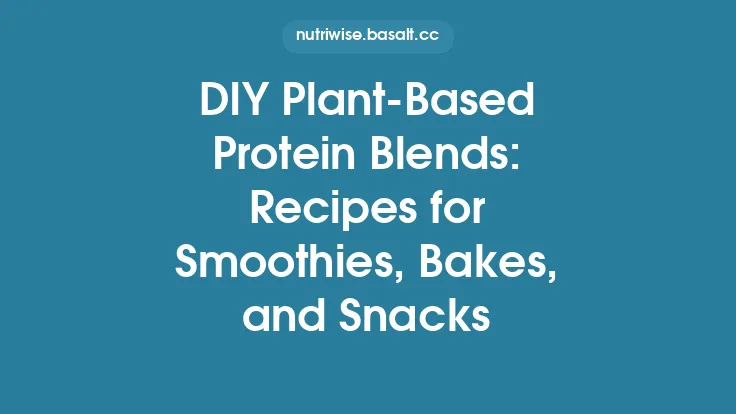When it comes to keeping both kids and adults satisfied between meals, snacks are the unsung heroes of a well‑balanced diet. The challenge multiplies when you have to navigate a household that lives with one or more food allergies. The good news is that a world of tasty, nutritious, and truly safe snack options exists—many of them require only a few staple ingredients and a little planning. Below you’ll find a comprehensive guide that walks you through the fundamentals of allergy‑safe snacking, offers concrete ideas for every age group, and equips you with the tools to keep cross‑contamination at bay.
Understanding Common Food Allergens and Their Impact on Snacks
Before diving into specific snack ideas, it’s essential to know which allergens are most likely to appear in everyday snack foods. The eight major allergens—often referred to as the “Big 8”—are:
| Allergen | Typical Sources in Snacks | Common Hidden Forms |
|---|---|---|
| Peanuts | Peanut butter, trail mixes, granola bars | Peanut oil, “nut‑flavored” seasonings |
| Tree nuts | Almonds, cashews, pistachios, nut‑based spreads | Nut flours, nut extracts |
| Milk/Dairy | Cheese sticks, yogurt, butter, whey protein | Casein, lactalbumin, milk solids |
| Eggs | Meringues, baked goods, mayonnaise | Albumin, egg whites, lecithin |
| Soy | Soy sauce, tofu, edamame, soy protein | Hydrolyzed soy protein, soy lecithin |
| Wheat/Gluten | Crackers, pretzels, wheat‑based cereals | Maltodextrin, modified food starch |
| Shellfish | Shrimp chips, fish sauce, crab meat | Shellfish extracts, “sea‑flavor” powders |
| Sesame | Tahini, sesame oil, sesame seeds | Sesame flour, sesame‑derived flavorings |
Even if a snack appears “plain,” it may contain trace amounts of these allergens through shared manufacturing lines or added flavor enhancers. Understanding where these hidden forms hide is the first line of defense.
Core Principles of Allergy‑Safe Snack Planning
- Start with Whole, Unprocessed Foods
Fresh fruit, raw vegetables, and plain cooked grains are naturally free of the Big 8 unless contaminated during handling.
- Choose Certified Allergen‑Free Products
Look for labels such as “Certified Allergen‑Free,” “Free From [Allergen],” or third‑party certifications (e.g., FARRP, Allergy Certified). These programs require rigorous testing and dedicated production lines.
- Create a “Safe Zone” in Your Kitchen
Designate a specific countertop, cutting board, and set of utensils for allergen‑free preparation. Keep these items separate from those used for allergen‑containing foods.
- Batch‑Cook and Portion
Preparing larger quantities of a safe snack (e.g., roasted chickpeas, baked sweet potato wedges) and dividing them into individual containers reduces daily prep time and limits exposure.
- Educate Everyone Involved
Whether it’s a caregiver, teacher, or coworker, ensure they understand the severity of the allergy, the signs of an allergic reaction, and the exact steps to take in an emergency.
Snack Ideas for Kids
Fresh Produce with Fun Dips
- Apple Slices + Sunflower Seed Butter
Sunflower seed butter mimics the creamy texture of peanut butter without the nut risk. Pair with a drizzle of honey (if age‑appropriate) for extra sweetness.
- Carrot Sticks + Avocado Yogurt Dip
Blend ripe avocado with coconut‑based yogurt, a squeeze of lime, and a pinch of sea salt. The dip is creamy, dairy‑free, and visually appealing when served in a small, colorful bowl.
- Cucumber Coins + Hummus (Chickpea‑Based)
Classic hummus is soy‑free and can be flavored with roasted red pepper or mild cumin for variety.
Crunchy, Shelf‑Stable Snacks
- Roasted Chickpeas
Toss canned chickpeas (rinsed and dried) with olive oil, a dash of smoked paprika, and a pinch of sea salt. Roast at 400 °F (200 °C) for 25‑30 minutes until crisp.
- Popcorn (Air‑Popped) + Nutritional Yeast
Nutritional yeast adds a cheesy flavor without dairy. Sprinkle lightly with a pinch of garlic powder for extra zest.
- Rice Cakes Topped with Mashed Banana and Cinnamon
Choose plain, gluten‑free rice cakes. The banana adds natural sweetness, while cinnamon offers a warm flavor profile.
Sweet Treats That Feel Like Desserts
- Frozen Berry Pops
Blend frozen mixed berries with a splash of coconut water, pour into silicone molds, and freeze. No added sugars needed—the fruit’s natural sweetness shines.
- Date‑Based Energy Balls
Pulse pitted Medjool dates with rolled oats (certified gluten‑free), pumpkin seeds, and a dash of vanilla extract. Roll into bite‑size balls and refrigerate.
- Coconut‑Milk “Pudding”
Whisk together full‑fat coconut milk, a tablespoon of chia seeds, and a drizzle of maple syrup. Let sit for 15 minutes; the chia seeds swell, creating a pudding‑like texture.
Snack Ideas for Adults
Savory, Protein‑Rich Options
- Edamame‑Free “Soy‑Free” Bean Salad
Combine cooked black beans, corn kernels, diced red bell pepper, and chopped cilantro. Dress with lime juice, olive oil, and a pinch of cumin.
- Quinoa‑Free “Grain‑Free” Crackers
Mix ground flaxseed, psyllium husk, and water to form a dough. Roll thin, cut into squares, and bake until crisp. Serve with a drizzle of olive oil and sea salt.
- Turkey or Chicken Lettuce Wraps
Use butter lettuce leaves as a vessel for shredded rotisserie chicken, diced mango, and a squeeze of lime. Add a dash of chili flakes for heat.
Sweet, Energy‑Boosting Snacks
- Apple “Nachos”
Slice an apple into thin rounds, spread with sunflower seed butter, and sprinkle with toasted pumpkin seeds, shredded coconut, and a drizzle of honey.
- Homemade Fruit Leather
Puree ripe peaches or mangoes, spread thinly on a parchment‑lined baking sheet, and dehydrate at low temperature (around 140 °F/60 °C) for 6‑8 hours. Cut into strips for a portable snack.
- Almond‑Free “Nut” Bars
Combine toasted sunflower seeds, pumpkin seeds, dried cranberries, and oat flakes (gluten‑free) with a binder of melted coconut oil and a touch of agave syrup. Press into a pan, chill, and slice.
On‑the‑Go Convenience
- Pre‑Portioned Trail Mix (Seed‑Based)
Mix roasted sunflower seeds, pumpkin seeds, dried apricots, and coconut flakes. Store in small zip‑top bags for quick grab‑and‑go.
- Mini “Muffin” Cups (Savory)
Whisk together eggs (or an egg‑free binder like chickpea flour), diced zucchini, shredded carrots, and a pinch of turmeric. Pour into silicone muffin molds and bake until set. These are perfect cold or reheated.
- Cold‑Pressed Vegetable Juice
Blend cucumber, celery, green apple, and a splash of lemon. Strain if desired, and store in a sealed bottle. It’s a hydrating snack that also supplies vitamins.
Ingredient Swaps and Substitutions
| Desired Texture/Flavor | Common Allergen | Safe Substitute |
|---|---|---|
| Creamy Spread | Peanut Butter | Sunflower Seed Butter, Tahini (if sesame‑tolerant) |
| Cheesy Flavor | Dairy Cheese | Nutritional Yeast, Vegan Cheese (soy‑free) |
| Crunchy Nut | Almonds | Roasted Pumpkin Seeds, Toasted Coconut Flakes |
| Egg Binder | Eggs | Flaxseed Meal + Water (1 tbsp + 3 tbsp), Chickpea Flour + Water |
| Gluten Structure | Wheat Flour | Rice Flour, Sorghum Flour, Tapioca Starch (all certified gluten‑free) |
| Soy Sauce | Soy | Coconut Aminos, Bragg’s Liquid Aminos (if soy‑free) |
| Sweetener | Honey (if avoiding animal products) | Maple Syrup, Agave Nectar |
When swapping, keep an eye on the moisture balance. For example, flaxseed “egg” adds extra liquid, so you may need to reduce other wet ingredients slightly.
Managing Cross‑Contamination at Home
- Dedicated Storage
Use clear, labeled containers for allergen‑free snacks. Store them on a separate shelf from allergen‑containing items.
- Cleaning Protocol
After preparing a snack that contains an allergen, wash all surfaces, utensils, and hands with hot, soapy water. For high‑risk allergens (e.g., peanuts), consider a sanitizing wipe or a brief run through a dishwasher.
- Separate Cooking Appliances
If you frequently bake, allocate a specific oven rack or toaster for allergen‑free foods. The same applies to toasters, grills, and microwaves.
- Label Everything
Even if a snack is homemade, label the container with the date, ingredients, and any allergens it *does not* contain. This practice is especially helpful in shared environments like schools or workplaces.
Reading Labels and Recognizing Certification Marks
- Allergen Statements
In many countries, manufacturers must list the top allergens in bold or a separate “Contains” box. Look for phrases like “May contain traces of…” and treat those products as unsafe for highly sensitive individuals.
- Certification Logos
- FARRP (Food Allergen Research & Resource Program) – Indicates rigorous testing for the Big 8.
- Allergy Certified™ – Third‑party verification that the product is produced in a dedicated allergen‑free facility.
- Gluten‑Free Certification (if relevant) – Look for the “Certified Gluten‑Free” seal from the Gluten Intolerance Group.
- Ingredient Order
Ingredients are listed in descending order by weight. If an allergen appears early in the list, the product likely contains a significant amount.
Storing and Preparing Snacks Safely
| Snack Type | Ideal Storage | Shelf Life (Approx.) |
|---|---|---|
| Fresh Fruit (cut) | Airtight container in fridge | 3‑5 days |
| Roasted Chickpeas | Sealed jar at room temperature | 1‑2 weeks (crisp) |
| Popcorn | Resealable bag in pantry | 1 month |
| Energy Balls | Refrigerated in a single layer | 1 week (or freeze for 3 months) |
| Homemade Fruit Leather | Zip‑top bag in freezer | 6 months |
| Seed‑Based Trail Mix | Vacuum‑sealed bag in pantry | 2‑3 months |
When preparing snacks for a group, always keep a master list of ingredients used that day. This record helps quickly identify any accidental exposure.
Building a Balanced Snack Routine
A well‑rounded snack should combine carbohydrates, protein, and healthy fats to sustain energy and curb cravings. Here’s a quick formula you can apply:
Snack = 1 portion fruit/veg + 1 portion protein/fat + optional whole‑grain or seed base
- Portion examples
- Fruit/veg: ½ cup sliced apple, 1 small banana, or 1 cup baby carrots.
- Protein/fat: 2 tbsp sunflower seed butter, ¼ cup roasted pumpkin seeds, or ½ cup hummus.
- Base: 1 rice cake, ¼ cup gluten‑free oat flakes, or a small handful of popped popcorn.
By rotating through the snack ideas above, you’ll keep meals interesting while ensuring that every bite is safe for those with food allergies.
Resources and Tools for Ongoing Success
- Allergy‑Safe Recipe Apps – Many free apps let you filter recipes by allergens, saving you time when planning snacks.
- Ingredient Substitution Guides – Websites like “The Allergy Kitchen” provide printable charts for quick reference.
- Local Support Groups – Connecting with other families dealing with similar allergies can uncover hidden gem snack ideas and trusted brands.
- Emergency Action Plans – Keep a printed plan (including epinephrine auto‑injector locations) in the kitchen, school bag, and workplace.
By grounding your snack strategy in whole, naturally allergen‑free foods, using certified products when processing is required, and maintaining strict cross‑contamination controls, you can create a snack environment that feels safe, enjoyable, and nutritionally sound for both kids and adults. The ideas presented here are evergreen—meaning they’ll stay relevant regardless of seasonal trends or fleeting diet fads—so you can rely on them year after year, adapting as needed to the specific allergies present in your household. Happy snacking!





